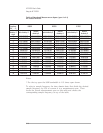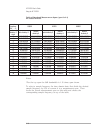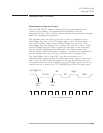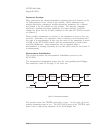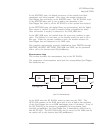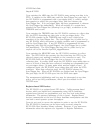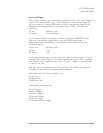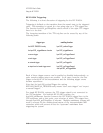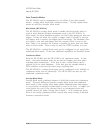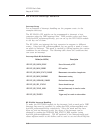
Upon entering the ARM state the HP E1433A starts saving new data in its
FIFO. It remains in the ARM state until the Sync/Trigger line goes high. If
the HP E1433A is programmed with a pre-trigger delay, it collects enough
data samples to satisfy this pre-trigger delay, and then releases the
Sync/Trigger line. If no pre-trigger delay has been programmed, it releases
the Sync/Trigger line immediately. When all modules in a system have
released the Sync/Trigger line (allowing it to go high), a transition to the
TRIGGER state occurs.
Upon entering the TRIGGER state the HP E1433A continues to collect data
into the FIFO, discarding any data prior to the pre-trigger delay. The
HP E1433A remains in the TRIGGER state until it sees a high-to-low
transition of the Sync/Trigger line. The Sync/Trigger line is pulled low by
any HP E1433A which encounters a trigger condition and is programmed to
pull the Sync/Trigger line. If any HP E1433A is programmed for auto
triggering (with hpe1432_setAutoTrigger), the Sync/Trigger line is pulled
low immediately. The Sync/Trigger line may also be pulled low by an
explicit call to the function hpe1432_triggerMeasure.
Upon entering the MEASURE state the HP E1433A continues to collect
data. The HP E1433A also presents the first data from the FIFO to the
selected output port, making it available to the controller to read. The
HP E1433A holds the Sync/Trigger line low as long as it is actively
collecting data. In overlap block mode the HP E1433A stops taking data as
soon as a block of data has been collected, including any programmed pre-
or post-trigger delays. (It starts again when another trigger occurs). In
continuous mode, the HP E1433A stops taking data only when the FIFO
overflows. When data collection stops, the HP E1433A releases the
Sync/Trigger line. When all HP E1433As are finished and the Sync/Trigger
line goes high, the HP E1433A goes into the IDLE state again.
The measurement initialization and loop may be interrupted at any time
with a call to hpe1432_resetMeasure, which puts the module in the
TESTED state.
Register-based VXI Devices
The HP E1433A is a register-based VXI device. Unlike message-based
devices which use higher-level programming using ASCII characters,
register-based devices are programmed at a very low level using binary
information. The greatest advantage of this is speed. Register-based
devices communicate at the level of direct hardware manipulation and this
can lead to much greater system throughput.
Users do not need to access the registers in order to use the HP E1433A.
The HP E1433A’s functions can be more easily accessed using the
HP E1433A Host Interface Library software. However, if you want more
information about the registers see Appendix A: Register Definitions.
HP E1433A User's Guide
Using the HP E1433A
3-26



